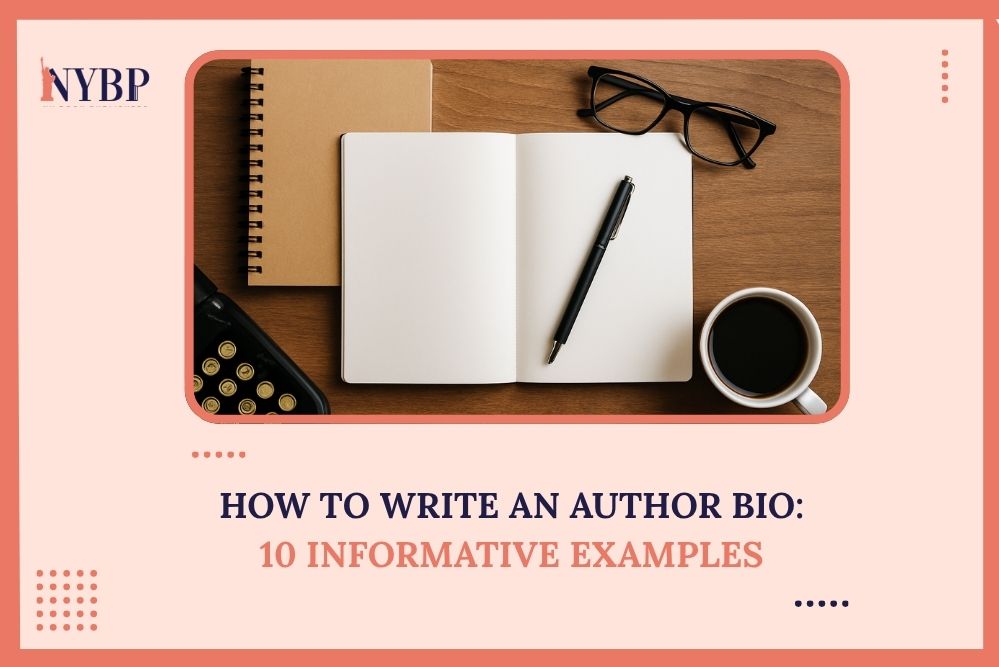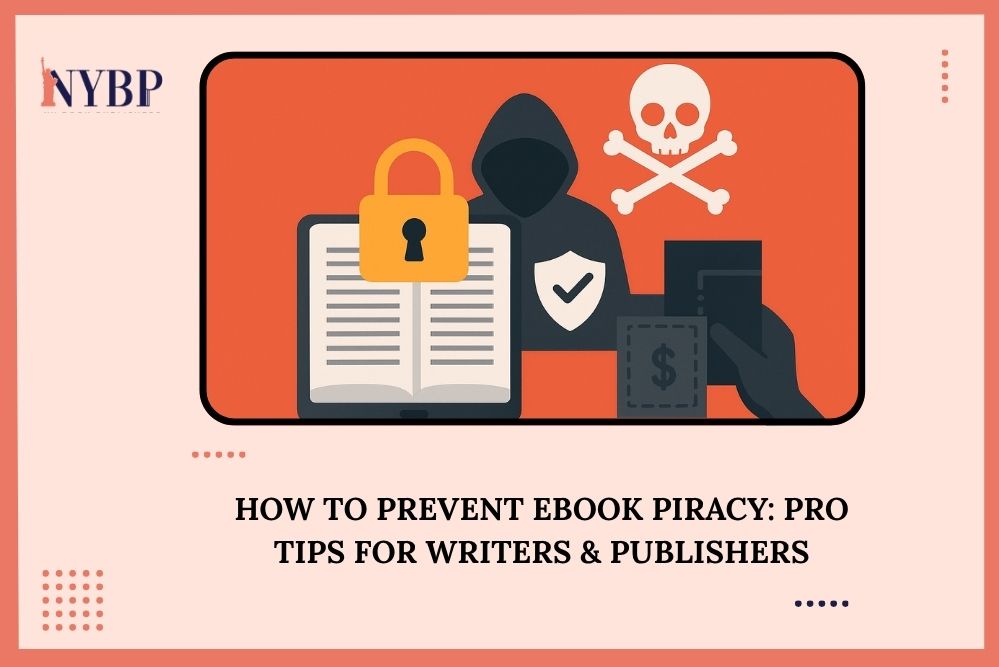Every writer reaches a point when the question arises: how do I describe myself to the world? Whether it’s for your book cover, author website, or an “About the Author” page, your bio becomes your first impression. It’s not just a short paragraph; it’s a bridge between you and your readers.
In a world filled with countless stories and storytellers, a strong author bio helps your name stand out. It tells people who you are, what you write, and why they should trust your voice. If done right, it builds connection and curiosity.
In this guide, we’ll walk you through everything you need to know, what an author bio is, why it matters, how to write an author bio step by step, and 10 inspiring examples from real authors across different genres. Let’s begin the journey of crafting a bio that truly represents you.

What Is An Author Bio?
An author bio is a short, polished paragraph that tells readers who you are. It usually appears at the end of a book, on an author website, or on a publisher’s page. Think of it as your personal introduction, your handshake in words.
Your book bio typically includes your name, what you write, your achievements, education, awards, and sometimes a touch of personality, such as where you live or what inspires your writing. It is not meant to list your entire life story but to give readers a glimpse into the person behind the words.
There are different types of author bios. A short author bio, around 50 to 100 words, works best for websites and social media. A longer version, about 150 to 300 words, is suitable for book covers or press materials.
A good author bio balances professionalism and authenticity. Readers want to feel connected to you, not overwhelmed with details. The best bios sound genuine, natural, and engaging rather than like a resume. Whether you are a first-time writer or a bestselling novelist, your author bio is your story told simply and sincerely.

Importance Of Writing An Author Bio
Your author bio is more powerful than most writers realize. It is your personal brand statement, credibility builder, and emotional connector, all rolled into one.
When someone picks up your book or visits your page, your bio becomes their first chance to know you. If your bio feels authentic and confident, it builds trust. Readers think, this person writes with passion; I want to read more.
For emerging authors, a well-written book bio can open doors. It can attract publishers, agents, and media attention. For established writers, it strengthens their identity and reminds readers why they love their work.
An author bio is also an important part of marketing. It gives your audience a reason to remember you and helps with search visibility online. That is why many writers include a sample on the author page that reflects their tone and personality.
In short, your author bio is not just a formality. It is an introduction, an elevator pitch, and sometimes even your brand story, all in a few sentences. When written well, it leaves a lasting impression that inspires readers to explore your work.
How To Write An Author Bio
Writing an author bio may seem simple at first, but when you actually sit down to do it, the words don’t always come easily. What should you include? What should you leave out? And how do you make it sound confident but still human?
Your author bio is more than a short paragraph. It is the first impression readers, publishers, and even agents get of you. A well-written bio tells people who you are, what you write, and why they should remember your name. Let’s go step by step to make it easy and enjoyable.
Step 1: Start with Your Name and Genre
Begin with the basics. Introduce yourself and clearly mention what you write. Readers should instantly understand your name and your genre.
For example:
Sarah Jenkins is a contemporary romance author who finds beauty in everyday love stories.
Or:
Mark Ellison writes historical thrillers inspired by untold moments of World War II.
Keep this part simple and honest. Avoid overthinking it or using fancy words. This opening line sets the tone and gives readers a quick picture of you and your writing world.
Step 2: Add Your Accomplishments Thoughtfully
Now that you’ve told readers who you are, it’s time to show them what makes your work special. Include achievements, awards, or books you have written, but only the ones that truly matter.
For instance:
Her debut novel, “Falling Leaves,” won the Midwest Book Award in 2022 and was featured in The Book Reviewer’s Top 10 Reads.
If you don’t have big accomplishments yet, don’t worry. You can still sound professional and confident by highlighting your passion for writing or the themes you love to explore. For example:
He began writing short stories in high school and now shares heartfelt, character-driven fiction with readers who love emotional storytelling.
The idea is to show growth and enthusiasm without sounding like you are trying too hard.
Step 3: Show a Bit of Personality
Readers don’t just want to know your credentials; they also want to feel a connection. Add a personal touch that gives a glimpse of who you are beyond your books. You can mention where you live, what inspires you, or something you enjoy doing in your free time.
For example:
When she’s not writing, Sarah enjoys long hikes, experimenting with homemade lattes, and collecting vintage postcards that often inspire her story settings.
Your goal is to sound relatable and genuine, not robotic. A little personality makes you more memorable.
Step 4: Write in the Third Person
Even though it might feel more natural to talk about yourself using “I,” most author bios are written in the third person. It gives your bio a polished and professional tone.
For example, instead of saying:
I’m an author who writes cozy mysteries about small towns and secrets,
you would say:
Lydia Brooks writes cozy mysteries about small towns and secrets.
This is the standard for book covers, websites, and interviews. However, if you’re writing a short intro for your personal blog or social media, first person is completely fine.
Step 5: Match the Bio to the Platform
Not every bio should be the same length or tone. You can create different versions depending on where it will appear.
A short version, around 50 to 75 words, works well for social media or magazine bylines. A longer version, about 150 to 200 words, fits best for your author website or book jacket.
For example:
Short Bio (for Instagram):
Lydia Brooks writes cozy mysteries about small towns and big secrets. Her debut novel, “The Lantern’s Shadow,” arrives this fall.
Long Bio (for Website):
Lydia Brooks is the author of “The Lantern’s Shadow,” a cozy mystery series set in coastal Maine. A lifelong lover of puzzles and detective stories, she blends heartwarming characters with suspenseful plots. When she isn’t writing, she enjoys gardening and collecting vintage teacups.
Adjust your tone and detail according to the space and audience.
Step 6: Add a Call to Action (Optional)
If it feels natural, guide readers to learn more about you. You can mention your website, newsletter, or social media handles.
For example:
Find out more about her upcoming books and writing updates at www.sarahjenkinswrites.com.
This small addition can help readers stay connected and follow your journey as an author.
Step 7: Edit for Flow and Warmth
After writing your bio, read it out loud. Does it sound natural? Does it sound like you? If any sentence feels stiff, rewrite it in a friendlier tone. Avoid long, complicated sentences or overly formal words. Instead, write as if you’re introducing yourself to someone who just picked up your book. A natural flow and a kind voice will make your bio feel more personal and inviting.
Step 8: Use Keywords Wisely
If your bio will appear online, add search-friendly keywords that describe your genre or style. This helps new readers find you easily on platforms like Amazon or Google.
For instance:
Daniel Reeves is a fantasy author known for his vivid world-building and unforgettable characters.
You can use phrases like “romance author,” “memoir writer,” or “children’s book author” naturally, without forcing them in. The goal is to be discoverable, not to sound like an ad.
Step 9: Avoid Common Mistakes
There are a few things that can make a bio feel weak or awkward. Try to avoid these:
- Writing in first person when third person is expected
- Sharing too much personal information
- Copying someone else’s tone or wording
- Making it too long or too vague
Your bio should feel unique to you and align with the way you write. It doesn’t need to sound perfect, just honest and clear.
Step 10: Keep It Updated
Your bio should grow with you. Update it whenever something changes—whether it’s a new book release, an award, or even a new city you’ve moved to. A current bio makes you look active, engaged, and professional. You can keep a few different versions saved so you can quickly update them when needed. Think of it as a living part of your author journey, always ready to evolve as you do.
Writing your author bio is simply about sharing your story with a touch of heart. Be yourself, speak with warmth, and let your readers feel like they are meeting the person behind the words. When you do that, your bio becomes not just an introduction, but an invitation into your world.
A Fillable Template To Write Your Author Bio
Here’s a quick template you can personalize:
[Your Name] is a [genre/type of writing] author known for [notable work or theme].
Their book [book title] [achievement or recognition].
[He/She/They] live(s) in [location] and enjoy(s) [personal interest or hobby].
Learn more at [your website or social handle].
Example:
Lena Brooks is a mystery novelist known for “The Midnight Key.” Her debut book was shortlisted for the Edgar Award. She lives in Chicago and enjoys collecting antique keys.
Contact NY Book Publishers and Let Our Experts Handle It
Writing your own author bio can be tricky. You know your story best, but putting it into words that sound natural, confident, and engaging takes skill. That’s where NY Book Publishers can help. Our professional editors and book marketing experts know how to highlight your strengths while keeping your bio relatable and genuine. Whether you’re a first-time author or an experienced writer, we’ll create a bio that connects with your readers and complements your brand.
We don’t just edit, we listen. We take the time to understand your journey, genre, and goals. From a short author bio for your website to a polished version for your book jacket, we’ll make sure it represents you perfectly. Let your writing shine while we handle the words that introduce you to the world.
Reach Out To NY Book Publishers Today!
Let Your Bio Tell Your Story
Your author bio is not just a formality. It is your story told in a few lines, a window that lets readers see who you are beyond the pages of your book. When you write it with honesty, clarity, and a little personality, it does more than introduce you. It builds trust, connection, and curiosity. Take time to shape it with care. Whether you are an emerging writer or an established author, your bio grows with you. Keep it updated, keep it real, and let your words reflect both your work and your heart. A great author bio reminds readers why they picked up your book in the first place, because they wanted to know the person behind the story. If you ever feel unsure, remember that your voice is enough. Be proud of it and let it shine through every word.
Frequently Asked Questions
What is an example of an author bio?
An author bio is a short paragraph that tells readers who you are and what you write. For example:
Emma Lewis is the author of “Under the Willow Tree,” a heartwarming novel about love and belonging. She lives in Chicago with her husband and two cats and enjoys writing stories that celebrate simple moments.
How can I write my own author bio?
Start with your name and the type of books you write. Add your achievements or publications, then include a personal detail that helps readers connect with you. Keep it short, natural, and written in the third person. Avoid sounding too formal or promotional.
What is a good bio example?
A good author bio feels genuine and easy to read. It shows confidence without bragging and gives readers a reason to remember you. For example:
Michael Carter writes fast-paced crime thrillers set in New York City. His debut book “City Shadows” received critical praise for its gripping plot. When he is not writing, he enjoys photography and exploring old bookstores.
What should I avoid in a bio?
Avoid using long or complicated sentences, overloading your bio with too many details, or writing in first person when third person is expected. Skip unnecessary personal information and do not try to sound overly formal. Keep it warm, confident, and clear.
What are common biography writing mistakes?
Some common mistakes include writing bios that are too long, copying other authors’ styles, using stiff or robotic language, or forgetting to update your bio over time. Another mistake is trying to sound impressive instead of authentic. Readers appreciate honesty far more than perfection.





